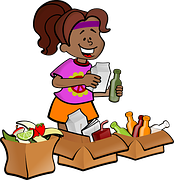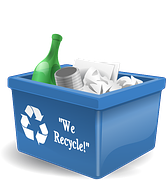Waste - Waste Prevention - Recycle

We must remember that recycling should be our third option after reducing the amount of stuff we bring into our homes and trying to reuse it in some other way before thinking of salving our consciences by dropping it into the recycling bin!! We all know there's nothing like unburdening yourself of a load of bottles and packaging at the bring bank, and then going home with a warm feeling of virtue. What's more, we're getting better and better at recycling: a target set to recycle 35% of materials by 2013 was actually reached in 2005, and 40% of municipal waste was recycled in Ireland in 2012. However there are lots of other countries doing a lot better than us!.. For example, Switzerland, the Netherlands and Germany recycle around 60% of their waste.
However, there are still a lot of us out there who don’t even bother to recycle at all and end up sending two-thirds of our recyclable household waste to landfill. We could be composting more of our organic matter, and making more of an effort to keep paper, metals and textiles out of the dump.
Did you know?

However, there are still a lot of us out there who don’t even bother to recycle at all and end up sending two-thirds of our recyclable household waste to landfill. We could be composting more of our organic matter, and making more of an effort to keep paper, metals and textiles out of the dump.
- It is estimated that around 80% of the contents of your rubbish bin can be recycled.
- We produce and use twenty times more plastic today than we did 50 years ago.
- Recycling one glass jar saves enough energy to light a light bulb for 4 hours.
- Every 2 seconds, an area of ancient forest the size of Croke Park is destroyed so recycling our paper and purchasing timber/furniture from properly managed forests in vital.
- For every tonne of paper used for recycling, 17 trees are spared, 31,500 litres of water are saved and 4200 KWh less electricity is used.
- Plastic production uses 8% of the world's oil production.
- For every tonne of recycled glass used, 1.2 tonnes of raw materials are preserved.
- The average child uses up to 5,000 nappies on his or her way to being potty trained. 4% of our waste consists of disposable nappies. Help the environment and save yourself some money - use eco-nappies for your baby.
- When it comes to recycling it's important to understand what items can be recycled and what the recycling symbols. Follow the links below to learn more about what can be recycled and recycling symbols.
- Textiles that are not used by charities are shredded into fibres & used to make new products, such as sound-deadening materials for the automotive industry, archival-quality paper, blankets and even plastic fencing!
Preparing for Recycling
Before you recycle it is important to know whether items need to be prepared for recycling or not. For example, whether they need to be washed or flattened etc. Waste that is not segregated properly can be difficult to recycle. It is also useful to know where you can recycle different waste streams. In order to make recycling as easy as possible we have put some tips together:
Preparation necessary:

Products and packaging often have some kind of recycling symbol on them. The most common is the mobius loop, which can mean that a product is either recyclable or has some recycled content. Unless the product states the percentage of recycled content, the symbol usually means that the product can be recycled. This does not mean that it will be recycled or that such facilities exist. Many products can be recycled in theory, but the technology or money may not be available to provide collection schemes for householders.
What can we recycle?

Note that what can and can’t be recycled varies in different local authority areas check your local authority website or commercial collector for details of their recycling schemes.
Glass
Glass is one of the best materials for recycling, as it can be recycled again and again, saving energy and raw materials. Before recycling your glass, make sure you wash the bottles and jars, and remove any tops or plastic attachments. Bottle banks are found in many supermarket car parks and local authority areas and usually have separate compartments for clear, green and brown glass. Blue glass can be put into the green bank and clear glass with coloured coatings can be put into the clear bank as the coating will burn off. The labels on bottles and jars will be removed during the recycling process; however remove as many plastic or metal rings and tops as possible. Only recycle bottles and jars - never light bulbs, window or sheet glass or Pyrex type dishes as these are made from a different type of glass.
Paper and cardboard
Recycling paper reduces pressure on natural resources and uses 30-70% less energy than producing paper from virgin materials. Almost a quarter of all household waste and a half of all commercial waste in Ireland is paper. Newspapers, magazines, junk mail and cardboard packaging can all be recycled either through kerbside collection or through local bring centres. Packaging such as milk and juice cartons cannot be recycled as paper as they have a plastic lining which would contaminate the process.
Metals
Unlike many materials, aluminium can be recycled indefinitely without deteriorating; and it more than covers its reprocessing costs. By recycling our cans we're only using only 5 per cent of the energy needed for virgin aluminium. So make sure to recycle all your tins and cans. Don't forget your aerosol cans are recyclable, just like any other steel or aluminium container. All our cans are shipped to Warrington, in Cheshire, to Novelis, Europe's only dedicated aluminium-can recycling plant. We're paid well for our used beverage containers - about £800 a tonne. You need 65,000 cans to make a tonne, which means we're getting about 3c for each one (see letsrecycle.com for more). Many local authorities have mixed can banks accepting both aluminium and steel cans, although some have aluminium-only banks as uncontaminated aluminium has a higher value. Try to crush drinks cans before recycling, either with a can crusher or by squashing them underfoot.
Plastics
In Ireland alone it is estimated that about 120,000 tonnes of plastic waste are produced each year. Plastic is a difficult material to recycle as there are many different types of plastic (often indicated by a number, or letters such as PET or PVC). The variation in plastic types means that different reprocessing techniques are required. Two kinds of plastic are accepted at almost all plastic-recycling facilities and in domestic green bins. The first, denoted by a number 1, is polyethylene terephthalate (PET or PETE), most commonly seen in clear plastic drink or water bottles. The second, number 2, is high-density polyethylene (HDPE), used in semi-rigid (that is, squeezable) bottles for shampoos, lotions and cleaning products, and in plastic milk containers. Screw caps for PET bottles (that is, plastic number 1) are made from HDPE (number 2), and are easier to process if you take them off the bottles before you recycle them. As for the other kinds of plastics, number 3 is polyvinyl chloride (PVC), found in some detergent bottles. The number 4 plastic is used for grocery bags, cling film and six-pack rings. The least favourite plastic of the five most common plastics is number 5, polypropylene (PP), used in food tubs and trays and in yogurt pots (but not in those little yogurt drink bottles, which are usually number 2/HDPE). Some recyclable plastics collected in Ireland are baled and sent to the UK or Holland as "mixed plastics". There they are separated into their plastic types and moved on for further processing. Drink bottles, for instance, may end up as fleece clothing or carpets; milk cartons may be born again as agricultural pipes or artificial timber. To find out more about the plastic recycling industry in Ireland see www.rx3.ie and then select plastics.
Electrical and Electronic Equipment & Batteries
Significant amounts of waste WEEE (Waste Electrical and Electronic Equipment) have been consigned over the years to landfill, taking up space and leaving behind environmentally damaging toxic substances. In Ireland, we have had a particular problem with fridges and cookers and other appliances being dumped on mountainsides and country lanes. Illegal dumping of this type of waste could have a possible negative impact on the environment and human health due to potentially hazardous substances that are generally associated with EEE.
Batteries are pretty nasty beasts. They come in different shapes and types and are consequently very difficult to sort and recycle. Rechargeable nickel cadmium batteries, like those in drill and mobile phones, do still contain hazardous metals and should be returned to the manufacturer where possible. If you use rechargeable batteries look out for the new versions containing no mercury or cadmium. The best plan? Use batteries as little as possible. Purchase a wind up watch, solar powered calculators, toys etc.
You can recycle the following:
- All batteries
- All electrical appliances large & small from your electric toothbrush to your fridge freezer
- Bulbs & Lighting Equipment
The Waste Electrical and Electronic Equipment (WEEE), website will have more information about what you can recycle and where, for example:
- Any Local Retailer selling portable batteries will take back your waste batteries for free recycling without any purchase necessary
- Large electrical retailers (Over 400 sq m) will take back small electrical appliances for free recycling with no purchase necessary
- Your retailer will recycle your large appliances on a one for one like for like basis
Also, a few Local Authorities provide facilities for recycling these, as well as lead acid car batteries, which may also be returned to garages. In 2013 a total of 42,628 tonnes of waste electrical and electronic equipment (WEEE) was collected for recovery. This included 7.2kg per person of household WEEE, exceeding the European Union (EU) target of 4kg per person. In 2013, Ireland achieved compliance with the 2006 EU targets, with 80 per cent reuse/recycling of End of Life Vehicles (ELVs), and 92 per cent for reuse/recovery of ELVs, but the 2015 targets are more onerous and are at risk.